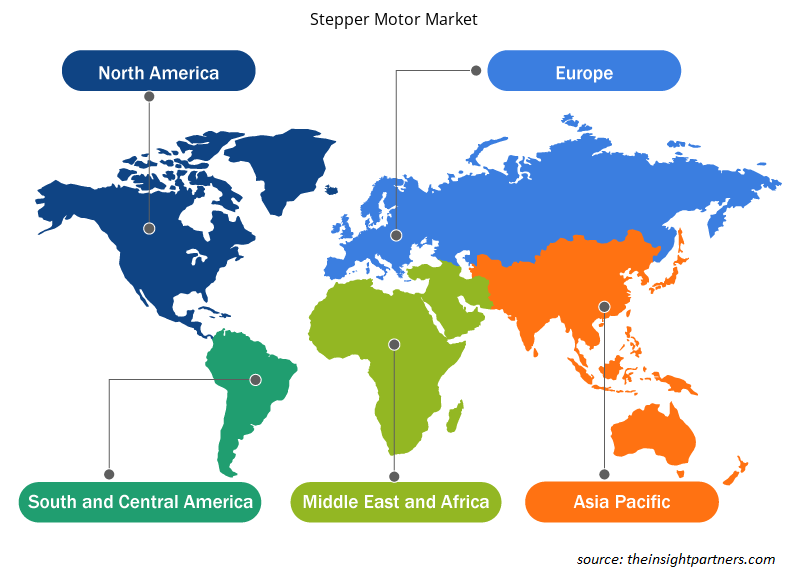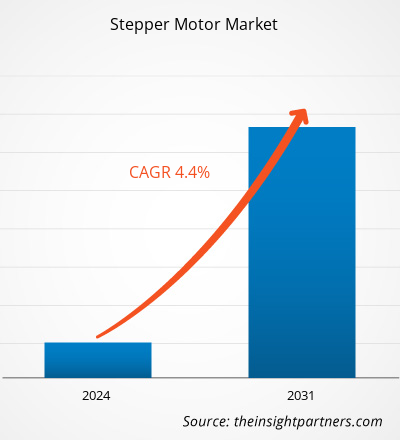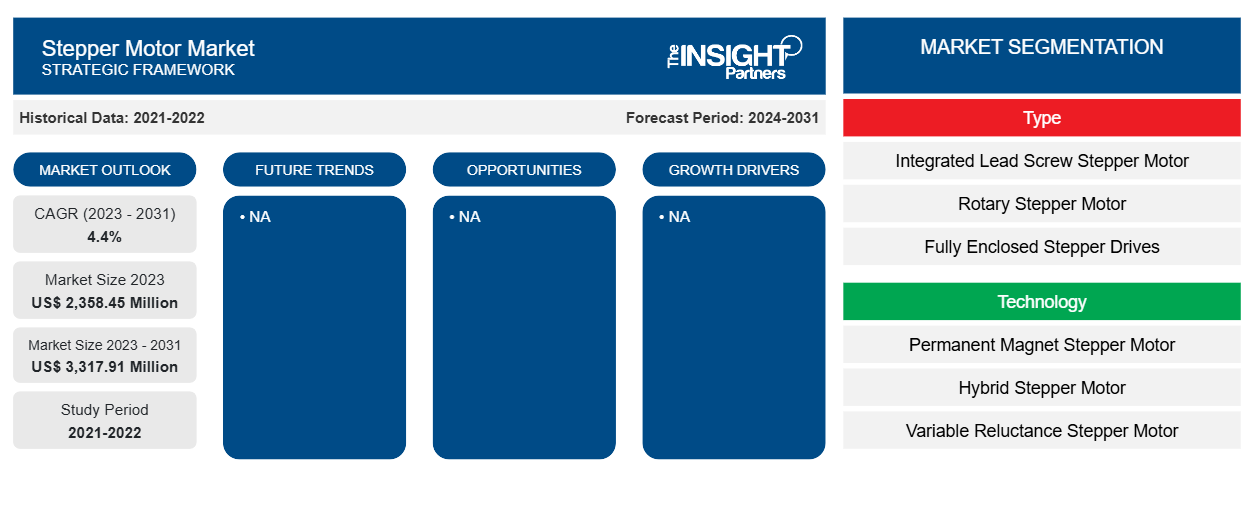Der Markt für Schrittmotoren soll von 2.358,45 Millionen US-Dollar im Jahr 2023 auf 3.317,91 Millionen US-Dollar im Jahr 2031 anwachsen. Der Markt soll zwischen 2023 und 2031 eine durchschnittliche jährliche Wachstumsrate (CAGR) von 4,4 % verzeichnen. Die sich verändernde Präferenz der Hersteller hin zur Einführung des Konzepts Industrie 4.0 dürfte weiterhin ein wichtiger Trend auf dem Markt für Schrittmotoren bleiben.CAGR of 4.4% in 2023–2031. Shifting manufacturers' preference towards the adoption of the Industry 4.0 concept is likely to remain key stepper motor market trends.
Schrittmotor-Marktanalyse
Der Markt für Schrittmotoren wächst rasant, da Schrittmotoren zunehmend in der Produktion medizinischer Geräte eingesetzt werden und die Nachfrage der Kunden nach kostengünstigen und hochpräzisen Produkten steigt. Der Markt wächst stetig, angetrieben durch die schnelle Digitalisierung und industrielle Automatisierung. Darüber hinaus bieten der technologische Fortschritt und die Expansion der Roboterindustrie lukrative Möglichkeiten für Marktwachstum.
Schrittmotor-Marktübersicht
Ein Schrittmotor ist ein elektromechanisches System, das ein elektrisches Signal in ein mechanisches umwandelt. Diese Motoren sind dafür ausgelegt, eine definierte Bewegung auszuführen und eine bestimmte Position einzunehmen. Diese Bewegung wird bei Schrittmotoren durch ein von Spulen erzeugtes und von Magneten erfasstes Magnetfeld erreicht, das den rotierenden Teil dazu zwingt, zu reagieren und sich im Zustand mit der niedrigsten Energie (Gleichgewicht) auszurichten, was zu Bewegung führt. Daher bestehen Schrittmotoren häufig aus einem festen Element (dem Stator) aus zyklisch erregten Spulen und einem beweglichen Teil (dem Rotor) aus ferromagnetischem Material oder Magneten.
Schrittmotoren werden in einer Reihe von Anwendungen eingesetzt, darunter Robotik und Halbleiter, die aufgrund ihres überlegenen Designs und ihres rationalisierten Herstellungsprozesses hohe Präzision, Drehmomentgeschwindigkeit und Effizienz erfordern. Darüber hinaus finden Schrittmotoren ihren Weg in medizinische Anwendungen wie Röntgenscanner und Blutanalysegeräte. Günstige Investitionen in Medizin und Gesundheitswesen und die zunehmende Einführung technologisch fortschrittlicher Produkte kurbeln das allgemeine Marktwachstum an.
Passen Sie diesen Bericht Ihren Anforderungen an
Sie erhalten kostenlos individuelle Anpassungen an jedem Bericht, einschließlich Teilen dieses Berichts oder einer Analyse auf Länderebene, eines Excel-Datenpakets sowie tolle Angebote und Rabatte für Start-ups und Universitäten.
-
Holen Sie sich die wichtigsten Markttrends aus diesem Bericht.Dieses KOSTENLOSE Beispiel umfasst eine Datenanalyse von Markttrends bis hin zu Schätzungen und Prognosen.
Treiber und Chancen auf dem Schrittmotormarkt
Zunehmender Einsatz von Schrittmotoren bei der Herstellung medizinischer Geräte
Motoren sind auch ein wichtiger Bestandteil medizinischer Geräte. Die steigende Nachfrage nach Schrittmotoren bei der Herstellung von Röntgengeräten und Blutanalysegeräten dürfte den Markt im Prognosezeitraum ankurbeln. Die Expansion und die jüngsten Fortschritte in der Gesundheitsbranche, beispielsweise bei Sauerstoffkonzentratoren, führen zu einer zunehmenden Verwendung von Schrittmotoren in Lüftern zur Kühlung. Diese Motoren sind aufgrund ihrer geringen Größe und geringen Geräuschentwicklung ideal für medizinische Anwendungen und beflügeln den Markt.concentrator increases the use of stepper motors in fans to cool. These motors are ideal for medical applications due to their tiny size and low noise is fueling the market.
Technologischer Fortschritt – Eine Chance für Schrittmotoren
Technologische Fortschritte auf dem Markt für Schrittmotoren ermutigen Hersteller, wasserdichte Schrittmotoren zu entwickeln, was voraussichtlich erhebliche Marktchancen eröffnen wird. Die wasserdichten Schrittmotoren sind in der Verpackungsindustrie aufgrund ihres korrosionsfreien Betriebs sehr gefragt und werden bevorzugt. Die Expansion der Verpackungsindustrie schafft im Prognosezeitraum bemerkenswerte Marktchancen. Darüber hinaus unterstützen die erheblichen Vorteile von Schrittmotoren, wie z. B. geringe Geräuschentwicklung, zuverlässiger Betrieb, geringes Drehmoment, schnelles Anlaufverhalten und niedrige Maschinenkosten, den Benutzer dabei, die Maschine effizient zu betreiben. Diese Faktoren werden voraussichtlich im Prognosezeitraum neue Marktchancen eröffnen.
Segmentierungsanalyse des Schrittmotor-Marktberichts
Wichtige Segmente, die zur Ableitung der Schrittmotor-Marktanalyse beigetragen haben, sind Typ, Technologie und Endbenutzer.
- Basierend auf dem Typ ist der Schrittmotormarkt in Rotationsschrittmotoren, vollständig geschlossene Schrittantriebe und integrierte Schrittmotoren mit Leitspindel unterteilt. Das Segment der Rotationsschrittmotoren hatte im Jahr 2023 einen größeren Marktanteil.
- Nach Technologie ist der Markt in Permanentmagnet-Schrittmotoren, Hybrid-Schrittmotoren und Schrittmotoren mit variabler Reluktanz segmentiert. Das Segment der Hybrid-Schrittmotoren hatte im Jahr 2023 den größten Marktanteil.
- Nach Endverbraucher ist der Markt in Halbleiter, Verpackung und Etikettierung, medizinische Geräte, Industriemaschinen und andere unterteilt. Das Halbleitersegment hielt im Jahr 2023 den größten Marktanteil.
Schrittmotor-Marktanteilsanalyse nach Geografie
Der geografische Umfang des Marktberichts zum Schrittmotor ist hauptsächlich in fünf Regionen unterteilt: Nordamerika, Asien-Pazifik, Europa, Naher Osten und Afrika sowie Südamerika/Süd- und Mittelamerika.
In Bezug auf den Umsatz hatte der asiatisch-pazifische Raum den größten Marktanteil bei Schrittmotoren. Der Markt in dieser Region ist in China, Japan, Südkorea, Indien, Australien und den Rest des asiatisch-pazifischen Raums unterteilt. Diese Länder sind für ihre Elektronikmaterialindustrien bekannt, die erheblich zum Marktwachstum beitragen. Laufende Ausgaben in zahlreichen Branchen, wie der Medizin- und Roboterindustrie, werden den Markt im Prognosezeitraum voraussichtlich ankurbeln. Darüber hinaus führt der in den letzten Jahren in mehreren Branchen Indiens deutlich gestiegene Einsatz von Robotern zu einer Nachfrage nach Schrittmotoren zur Vereinfachung des Produktionsprozesses. Laut Robot Systems India Pvt Ltd hat die indische Fertigungsindustrie einen deutlichen Anstieg der Roboternutzung erlebt, wobei im Jahr 2022 etwa 5.500 Roboter installiert wurden. Dieses signifikante Wachstum des indischen Robotersektors schafft Möglichkeiten für das Marktwachstum. Darüber hinaus wird erwartet, dass kontinuierliche Verbesserungen der Spitzentechnologie und der Fertigungskapazitäten das Wachstum des Robotersektors in der Region beschleunigen und die Marktnachfrage steigern werden.
Regionale Einblicke in den Schrittmotormarkt
Die regionalen Trends und Faktoren, die den Schrittmotorenmarkt im Prognosezeitraum beeinflussen, wurden von den Analysten von Insight Partners ausführlich erläutert. In diesem Abschnitt werden auch die Marktsegmente und die Geografie des Schrittmotorenmarkts in Nordamerika, Europa, im asiatisch-pazifischen Raum, im Nahen Osten und Afrika sowie in Süd- und Mittelamerika erörtert.

- Holen Sie sich die regionalspezifischen Daten für den Schrittmotormarkt
Umfang des Marktberichts für Schrittmotoren
| Berichtsattribut | Details |
|---|---|
| Marktgröße im Jahr 2023 | 2.358,45 Millionen US-Dollar |
| Marktgröße bis 2031 | 3.317,91 Millionen US-Dollar |
| Globale CAGR (2023 - 2031) | 4,4 % |
| Historische Daten | 2021-2022 |
| Prognosezeitraum | 2024–2031 |
| Abgedeckte Segmente |
Nach Typ
|
| Abgedeckte Regionen und Länder |
Nordamerika
|
| Marktführer und wichtige Unternehmensprofile |
|
Dichte der Marktteilnehmer für Schrittmotoren: Auswirkungen auf die Geschäftsdynamik verstehen
Der Markt für Schrittmotoren wächst rasant, angetrieben durch die steigende Nachfrage der Endnutzer aufgrund von Faktoren wie sich entwickelnden Verbraucherpräferenzen, technologischen Fortschritten und einem größeren Bewusstsein für die Vorteile des Produkts. Mit steigender Nachfrage erweitern Unternehmen ihr Angebot, entwickeln Innovationen, um die Bedürfnisse der Verbraucher zu erfüllen, und nutzen neue Trends, was das Marktwachstum weiter ankurbelt.
Die Marktteilnehmerdichte bezieht sich auf die Verteilung von Firmen oder Unternehmen, die in einem bestimmten Markt oder einer bestimmten Branche tätig sind. Sie gibt an, wie viele Wettbewerber (Marktteilnehmer) in einem bestimmten Marktraum im Verhältnis zu seiner Größe oder seinem gesamten Marktwert präsent sind.
Die wichtigsten auf dem Schrittmotorenmarkt tätigen Unternehmen sind:
- ABB Ltd
- Angewandte Bewegungsprodukte, Inc.
- Delta Elektronik
- FAULHABER Gruppe
- National Instruments Corporation
- Nidec Corporation
Haftungsausschluss : Die oben aufgeführten Unternehmen sind nicht in einer bestimmten Reihenfolge aufgeführt.

- Überblick über die wichtigsten Akteure auf dem Schrittmotorenmarkt
Neuigkeiten und aktuelle Entwicklungen zum Schrittmotormarkt
Der Markt für Schrittmotoren wird durch die Erhebung qualitativer und quantitativer Daten nach Primär- und Sekundärforschung bewertet, die wichtige Unternehmensveröffentlichungen, Verbandsdaten und Datenbanken umfasst. Im Folgenden finden Sie eine Liste der Entwicklungen auf dem Markt für Schrittmotoren und Strategien:
- Im November 2023 hat die igus GmbH einen Doppelwellen-Schrittmotor für ihre drylin Lineartechnik auf den Markt gebracht. Mit ihm lassen sich zwei Linearachsen antreiben. Eine weitere Anwendungsmöglichkeit ist die Montage eines Handrads auf der zweiten Antriebswelle. Im Notfall können Anwender den Motor mit manueller Nullpunktkalibrierung per Hand drehen. (Quelle: igus GmbH, Pressemitteilung, 2023)
- Im September 2023 stellte die Kollmorgen Corporation den Schrittmotorantrieb P80360 vor, die neueste Ergänzung der P8000-Schrittmotorplattform des Unternehmens. Der P80360 verfügt über eine innovative stufenlose Steuerungstechnologie, die für gleichmäßige, leise Bewegungen und optimale Leistung über den gesamten Drehzahlbereich sorgt. Der Schrittmotorantrieb P80360 kann mit allen Schrittmotoren mit Phasenstrom bis zu 3,0 Arms verwendet werden. Er eignet sich ideal für Etikettiermaschinen, Indexiertische, CNC-Maschinen, XYZ-Portalsysteme wie 3D-Drucker, Verpackungen, medizinische Laborgeräte, Pumpen und viele andere Anwendungen, die einfache Punkt-zu-Punkt-Bewegungen sowie verknüpfte Bewegungssequenzen erfordern. (Quelle: Kollmorgen Corporation, Pressemitteilung, 2023)
- Im April 2023 bot die Nanotec Electronic GmbH & Co. KG geräuscharme Planetengetriebe für bürstenlose Gleichstrommotoren und Schrittmotoren mit NEMA 17-Flansch (42 mm) an. Die Getriebe sind in ein- und zweistufiger Ausführung mit sieben verschiedenen Untersetzungen erhältlich und bieten ein Abtriebsdrehmoment von 0,8 bis 4,9 Nm. Für den Einsatz in rauen Umgebungen sind die Getriebe nach IP54 gegen das Eindringen von Staub und Flüssigkeiten geschützt. (Quelle: Nanotec Electronic GmbH & Co. KG, Pressemitteilung, 2023)
Bericht zum Markt für Schrittmotoren – Umfang und Ergebnisse
Der Bericht „Marktgröße und Prognose für Schrittmotoren (2021–2031)“ bietet eine detaillierte Analyse des Marktes, die die folgenden Bereiche abdeckt:
- Marktgröße und Prognose auf globaler, regionaler und Länderebene für alle wichtigen Marktsegmente, die im Rahmen des Projekts abgedeckt sind
- Marktdynamik wie Treiber, Beschränkungen und wichtige Chancen
- Wichtige Zukunftstrends
- Detaillierte PEST/Porters Five Forces- und SWOT-Analyse
- Globale und regionale Marktanalyse mit wichtigen Markttrends, wichtigen Akteuren, Vorschriften und aktuellen Marktentwicklungen
- Branchenlandschaft und Wettbewerbsanalyse, einschließlich Marktkonzentration, Heatmap-Analyse, prominenten Akteuren und aktuellen Entwicklungen
- Detaillierte Firmenprofile
- Historische Analyse (2 Jahre), Basisjahr, Prognose (7 Jahre) mit CAGR
- PEST- und SWOT-Analyse
- Marktgröße Wert/Volumen – Global, Regional, Land
- Branchen- und Wettbewerbslandschaft
- Excel-Datensatz
Aktuelle Berichte
Verwandte Berichte
Erfahrungsberichte
Grund zum Kauf
- Fundierte Entscheidungsfindung
- Marktdynamik verstehen
- Wettbewerbsanalyse
- Kundeneinblicke
- Marktprognosen
- Risikominimierung
- Strategische Planung
- Investitionsbegründung
- Identifizierung neuer Märkte
- Verbesserung von Marketingstrategien
- Steigerung der Betriebseffizienz
- Anpassung an regulatorische Trends























 Kostenlose Probe anfordern für - Markt für Schrittmotoren
Kostenlose Probe anfordern für - Markt für Schrittmotoren